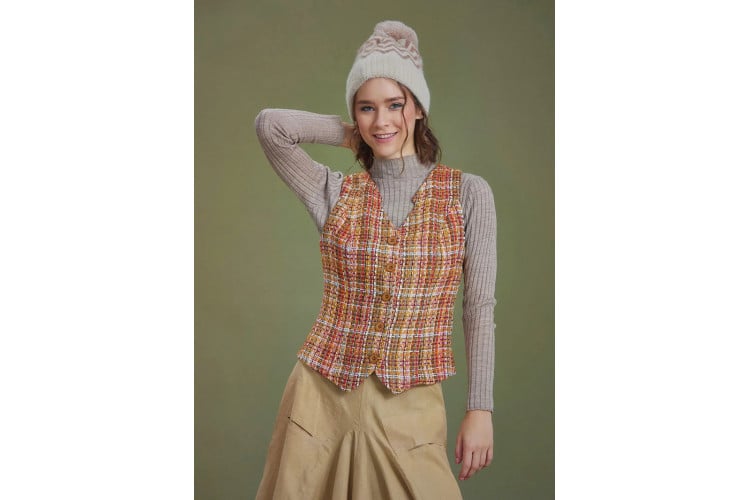How to Dress Like a Sixties Hippie Girl
14/01/2025 / Reading time: 5 mins.

Discover how to master 60s hippie fashion with flowing tops, maxi dresses, bell-bottoms, and iconic accessories. Embrace peace, love, and freedom in style.
The 1960s was a revolutionary decade defined by peace, love, and an outspoken rejection of societal norms. Hippie fashion emerged as a bold representation of these values, blending comfort, individuality, and a connection to nature.
Whether you're recreating the look for an event or incorporating it into your everyday style, mastering the hippie aesthetic is a journey into self-expression and freedom.

Embrace Flowing Tops and Dresses
Flowy tops and dresses were a hallmark of 60s hippie fashion. Tunics and caftans with wide sleeves and loose fits offered both comfort and style. Opt for tops in earthy tones like brown, green, or beige, or explore tie-dye patterns for a splash of vibrant creativity. Turtlenecks and tank tops also made their way into hippie wardrobes, especially in understated hues. For an authentic touch, consider the braless look — a popular choice among hippie women embracing natural freedom.
When it comes to dresses, maxi styles in light, breathable fabrics exude effortless grace. Pair them with floral, paisley, or animal prints to capture the free-spirited essence of the era. For a chic twist, experiment with A-line or shift-cut mini skirts — a staple of the decade's fashion — and wear them with black or patterned tights.
The Charm of Bell-Bottoms and Fringe
Bell-bottom jeans and corduroy pants epitomized the unstructured style of the 60s. These iconic trousers featured flared legs and a relaxed fit, often in rich jewel tones like maroon, mustard yellow, or forest green. Pair them with a tucked-in top or an embellished blouse for a harmonious look.
Fringe jackets and vests added texture and authenticity to hippie outfits. Suede and velvet materials were particularly popular, along with earth-toned ponchos and maxi coats. For a rebellious touch, opt for military-inspired green army jackets, which many wore as a statement against the establishment.
Accessories That Define the Hippie Look
Accessories played a vital role in hippie fashion, often reflecting personal values and creativity. Headbands and scarves tied across the forehead became iconic symbols of the movement. Choose braided leather, colorful fabrics, or floral garlands to elevate your look. Wide-brim hats and John Lennon-style round sunglasses — sometimes tinted in playful colors like pink or orange — completed the ensemble with a touch of whimsy.
Jewelry was bold and natural. Love beads, peace symbol necklaces, and handmade accessories crafted from wood, leather, or beads were staples of the era. Ankle bracelets with bells added a musical flair, while layered necklaces expressed individuality and creativity.
Hairstyles and Makeup for the Authentic Look
Hippie hairstyles were all about embracing natural beauty. Long, unstyled locks with a middle part were a hallmark of the era. Small braids, real flowers, or simple headbands added an ethereal touch. If you have curly or textured hair, opt for volume with an afro or a wild mane of curls.
Makeup was minimal, emphasizing authenticity. Eyeliner and mascara were the most commonly used products, while heavy foundation and lipstick were avoided. Many hippies favored natural scents like patchouli and sandalwood over artificial perfumes, aligning with their connection to nature.
Footwear That Embodies Comfort and Style
Hippies prioritized practicality and comfort when it came to footwear. Leather sandals, moccasins, and cowboy boots were popular choices. Many embraced the carefree spirit by going barefoot. For colder days, fringe-adorned boots provided both warmth and style, completing the relaxed and natural aesthetic.
DIY: Create or Find Your Own Hippie Pieces
Hippie fashion celebrated sustainability and creativity, making vintage and thrift stores ideal places to find authentic pieces. Look for embroidered skirts, patchwork shirts, or flowing maxi dresses. Garage sales and flea markets often hide unique gems that embody the era's essence.
For a personal touch, tie-dye your own shirts, scarves, or accessories. Use rubber bands to create patterns like spirals, stripes, or polka dots with fabric dyes. Alternatively, embellish existing clothes with fringe, beads, or embroidery for a one-of-a-kind statement piece. Sewing enthusiasts can use natural fabrics like cotton or hemp to create custom bell-bottoms or dresses, adding individuality to their wardrobe.
Inspiration from 60s Icons
The hippie style drew influence from cultural icons who embodied the values of the movement. Janis Joplin's flowing outfits and round glasses, Marsha Hunt's voluminous afro and ethereal maxi dresses, and Stevie Nicks' shawls and bohemian flair all provide timeless inspiration.
These figures showcased the versatility of hippie fashion, offering a mix of psychedelic patterns, earthy tones, and bold accessories. By studying their styles, you can craft a look that reflects your personality while staying true to the era.
Conclusion & Final Thoughts
The 60s hippie aesthetic is more than just a fashion statement; it's a celebration of freedom, individuality, and creativity. From flowing garments to natural hairstyles and handcrafted accessories, this iconic style continues to inspire modern fashion.
By embracing its spirit and values, you can craft a look that's uniquely yours while paying homage to an era that changed the world. Whether for a special occasion or everyday wear, the possibilities are as boundless as the peace and love that defined the decade.

